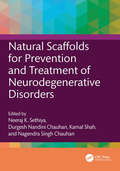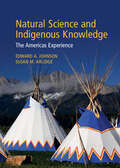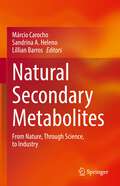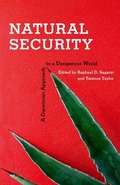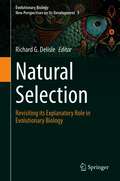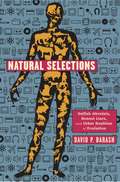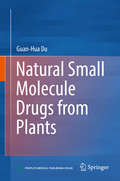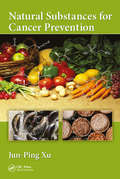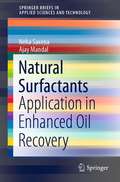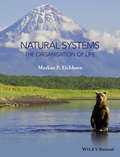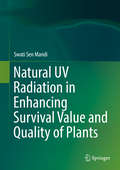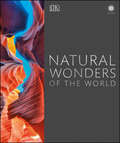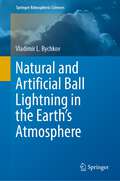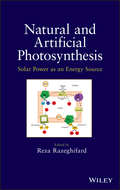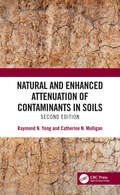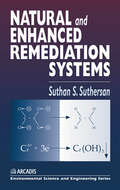- Table View
- List View
Natural Scaffolds for Prevention and Treatment of Neurodegenerative Disorders
by Durgesh Nandini Chauhan Nagendra Singh Chauhan Kamal Shah Neeraj K. SethiyaNeurodegenerative diseases affect millions of people worldwide and are a group of several diseases with distinct pathology, physiology, prevention, and treatment strategies. Recently, natural products especially derived from medicinal plants are gaining momentum to manage neurodegenerative disease safely and effectively. Therefore, there is an urgent need to provide a ready roadmap for scientifically validated value-added nutraceutical and pharmaceutical safe and effective product for the management of various neurodegenerative diseasesNatural Scaffolds for Prevention and Treatment of Neurodegenerative Disorders will provide compiled information stating several identified neurodegenerative diseases including pathology and physiology. From vast literature on natural products, such asscientifically validated plant bioactives, traditional approaches to combat or prevent neurodegenerative conditions are also included along with molecular mechanisms. The book will further specify: Single window complied information on various neurodegenerative diseases. Possible projection of bioactivity from natural resources to each category of neurodegenerative diseases. Ready-to-use reference material to develop several value-added products or proceed to the next level. The book will be very useful for nutraceutical research groups, education institutions, and industries focusing on developing value-added solutions for the management of several neurodegenerative diseases.
Natural Science
by Immanuel Kant Eric WatkinsThough Kant is best known for his strictly philosophical works in the 1780s, many of his early publications in particular were devoted to what we would call 'natural science'. Kant's Universal Natural History and Theory of the Heavens (1755) made a significant advance in cosmology, and he was also instrumental in establishing the newly emerging discipline of physical geography, lecturing on it for almost his entire career. In this volume Eric Watkins brings together new English translations of Kant's first publication, Thoughts on the True Estimation of Living Forces (1746-1749), the entirety of Physical Geography (1802), a series of shorter essays, along with many of Kant's most important publications in natural science. The volume is rich in material for the student and the scholar, with extensive linguistic and explanatory notes, editorial introductions and a glossary of key terms.
Natural Science and Indigenous Knowledge: The Americas Experience
by Edward A. Johnson Susan M. ArlidgeHow do we combine the areas of intersection between science and indigenous knowledge, but without losing the totality of both? This book's objective is to consider how Indigenous populations have lived and managed the landscape. Specifically, how their footprint was a result of the combination of their empirical knowledge and their culture. The chapters are divided into four groups: The first deals with reintegrating cultures and natural landscapes and the role of kinship and oral tradition. The second group approaches the landscape as a living university of learning and managing, discussing the ethnobotany of how to grow more responsibly, and assess and project the harvest. The third group deals with the managing of fire in an anthropogenic plant community and how to integrate indigenous agriculture in hydrology and dry regions. The fourth group consists of studies of how science and indigenous knowledge can be taught in schools using land-based studies.
Natural Secondary Metabolites: From Nature, Through Science, to Industry
by Lillian Barros Márcio Carocho Sandrina A. HelenoThis book focuses on the different compounds (polyphenols, sterols, alkaloids terpenes) that arise from the secondary metabolism of plants and fungi and their importance for research and industry. These compounds have been the backbone and inspiration of various industries like the food, pharmaceutical and others to produce synthetic counterparts. Furthermore, many of these compounds are still widely used to carry out specific functions in all these industries. This book offers a compilation of different texts from world leading scientists in the areas of chemistry, biochemistry, plant science, biotechnology which compile information on each group of secondary metabolism compounds, and their most important applications in the food, pharmaceutical, cosmetic and textile industry. By showcasing the best uses of these compounds, the chemistry behind their production in plants and fungi, this book is a valuable resource and a "go to" artifact for various audiences. The new approach this book offers, by linking research and the application of these compounds, makes it interesting as an inspiration for new research or as a hallmark of what has been done in the secondary metabolism of plants and fungi in recent years. Although this book may be technical, it is also enjoyable as an integral reading experience due to a structured and integrated flow, from the origins of secondary metabolism in organisms, to the discovery of their effects, their high intensity research in recent years and translation into various industries. Beyond learning more on their chemistry, synthesis, metabolic pathway, readers will understand their importance to different research and industry.
Natural Security: A Darwinian Approach to a Dangerous World
by Raphael D. Sagarin Terence TaylorThe post 9/11 world has so far failed to exploit the insights of the greatest experiment in security of all time--the millions of successful defensive and offensive security strategies that abound in nature. Arms races among invertebrates, intelligence gathering by the immune system, alarm calls by marmots are but a few of nature's security strategies that have been tested and modified over billions of years. This provocative book applies lessons from nature to our own toughest security problems-from global terrorism to the rise of infectious disease to natural disasters. Written by a truly multi-disciplinary group including paleobiologists, anthropologists, psychologists, ecologists, and national security experts, it considers how models and ideas from evolutionary biology can improve national security strategies ranging from risk assessment, security analysis, and public policy to long-term strategic goals. Written with the aim of breaking down barriers between disparate disciplines in order to create more responsive and effective strategies,Natural Security provides a new lens through which to explore the ancient and ever present problem of how to maintain security in an unpredictable, complex, and dangerous world.
Natural Selection: Revisiting its Explanatory Role in Evolutionary Biology (Evolutionary Biology – New Perspectives on Its Development #3)
by Richard G. DelisleThis book contests the general view that natural selection constitutes the explanatory core of evolutionary biology. It invites the reader to consider an alternative view which favors a more complete and multidimensional interpretation. It is common to present the 1930-1960 period as characterized by the rise of the Modern Synthesis, an event structured around two main explanatory commitments: (1) Gradual evolution is explained by small genetic changes (variations) oriented by natural selection, a process leading to adaptation; (2) Evolutionary trends and speciational events are macroevolutionary phenomena that can be accounted for solely in terms of the extension of processes and mechanisms occurring at the previous microevolutionary level. On this view, natural selection holds a central explanatory role in evolutionary theory - one that presumably reaches back to Charles Darwin's Origin of Species - a view also accompanied by the belief that the field of evolutionary biology is organized around a profound divide: theories relying on strong selective factors and those appealing only to weak ones. If one reads the new analyses presented in this volume by biologists, historians and philosophers, this divide seems to be collapsing at a rapid pace, opening an era dedicated to the search for a new paradigm for the development of evolutionary biology. Contrary to popular belief, scholars' position on natural selection is not in itself a significant discriminatory factor between most evolutionists. In fact, the intellectual space is quite limited, if not non-existent, between, on the one hand, "Darwinists", who play down the central role of natural selection in evolutionary explanations, and, on the other hand, "non-Darwinists", who use it in a list of other evolutionary mechanisms. The "mechanism-centered" approach to evolutionary biology is too incomplete to fully make sense of its development. In this book the labels created under the traditional historiography - "Darwinian Revolution", "Eclipse of Darwinism", "Modern Synthesis", "Post-Synthetic Developments" - are thus re-evaluated. This book will not only appeal to researchers working in evolutionary biology, but also to historians and philosophers."
Natural Selections
by David P. Barash"Barash . . . brilliantly integrat[es] science, literature, and pop culture into elegant and insightful commentaries on the most interesting and important questions of our time. A delightful read."--Michael Shermer, author of The Science of Good and Evil "Entertaining and thought-provoking."--Steven Pinker, author of The Blank Slate If we are, in part, a product of our genes, can free will exist? Incisive and engaging, this indispensable tour of evolutionary biology runs the gamut of contemporary debates, from science and religion to our place in the universe.
Natural Small Molecule Drugs from Plants
by Guan-Hua DuThis book discusses 120 types of natural, small-molecule drugs derived from plants. They are grouped into 7 parts according their clinical uses, such as drugs for cardiovascular diseases, for metabolic diseases, for neuropsychiatric diseases, for immune-mediated inflammatory diseases, anti-tumor drugs, and drugs for parasites and bacterial infection. Each chapter systematically summarizes one drug, including its physicochemical properties, sources, pharmacological effects and clinical applications. To help readers understand the drug better, the research and pharmacological activity for each drug is also described, which serves as a salutary lesson for future drug development. Written by frontline researchers, teachers and clinicians working in field of pharmacy and pharmacology it provides an overview of natural, small-molecule drugs derived from plants for researchers in the field.
Natural Substances for Cancer Prevention
by Jun-Ping XuNatural Substances for Cancer Prevention explores in detail how numerous investigations in chemical biology and molecular biology have established strong scientific evidence demonstrating how the properties of naturally occurring bioactive chemicals hamper all stages of cancers (from initiation to metastasis). Accordingly, important goals for cancer prevention are the modification of our dietary habits and an increase in the intake of more anticancer-related natural substances. More significantly, the bioactive chemicals presented in the functional foods should be readily available, inexpensive, non-toxic, and nutritional.
Natural Surfactants: Application in Enhanced Oil Recovery (SpringerBriefs in Applied Sciences and Technology)
by Neha Saxena Ajay MandalThis book focuses on the use of natural surfactants in enhanced oil recovery, providing an overview of surfactants, their types, and different physical–chemical properties used to analyse the efficiency of surfactants. Natural surfactants discuss the history of the surfactants, their classification, and the use of surfactants in petroleum industry. Special attention has been paid to natural surfactants and their advantages over synthetic surfactants, including analysing their properties such as emulsification, interfacial tension, and wettability and how these can be used in EOR. This book offers an overview for researchers and graduate students in the fields of petroleum and chemical engineering, as well as oil and gas industry professionals.
Natural Systems
by Markus EichhornOrganised into four sections, this text discusses the organisation of the living world. Links Ecology, Biodiversity and Biogeography Bridges modern and conventional Ecology Builds sequentially from the concept and importance of species, through patterns of diversity to help consider global patterns of biogeography Uses real data sets to help train in essential skills
Natural UV Radiation in Enhancing Survival Value and Quality of Plants
by Swati Sen MandiThisbook is the first of its kind to highlight the positive impact of natural UVradiation on plants through unique adaptations in various metabolic pathways, andprovides an evolutionary sketch of the development of molecular mechanisms forprotecting plants from solar UV ever since their migration to terrestrialhabitats. Experimental evidence is provided for establishing how plants, throughtheir stationary habit in the open field, survive and flourish by developing suitableUV acclimation strategies through the repair of damaged macromolecules and/orupregulation of screening compounds viz. flavonoids. Presenting an analysis of relatedliterature, it also highlights the importance of outdoor experiments over thosein closed chamber under artificial UV light for obtaining realistic data. The book presents a comprehensiveaccount of the stratospheric ozone layer, its formation and seasonal thinning,with particular reference to alarming anthropogenic destruction of the ozonelayer since the last quarter of the twentieth century, which has resulted in increasedUV fluence on Earth. It discusses variations in the hazardous impact of UV onlife at different latitudes through the ages, and examines altitudinal variationsin UV effects in case studies demonstrating high antioxidant content and aromastatus in Darjeeling tea leaves (at high altitudes) compared with those of the sametea clones in Assam leaves (at low altitudes), with both sites being at the samelatitude. It provides evidence which suggests that the UV effects relating tothe expression of seed vigour-viability could be epigenetic. Further, it presents recently developed microscopictechnologies for demonstrating the penetration of UV into plant cells, and discusseshow cellular metabolism can be affected either directly or via signaltransduction. Effect of damage in DNA (the key target of UV radiation) has beendemonstrated and estimated using precise techniques. The latest "FOX Hunting"technique as a useful means of transcriptome analysis that may be used fordeveloping UV tolerant plants through Marker Assisted Breeding has also beendiscussed. Using biochemical and biotechnological methods, the experimentspresented highlight the gene X environment based upregulation of specificmetabolic pathways, allowing i) value addition in plant-derived food, and ii) pavingthe way for the industrial manufacture of Alternative Medicine products. Thebook is enriched by a critical review of the available literature andappropriate case studies selected from the author's own findings, which span nearlyfour decades of active research.
Natural Wonders of the World (DK Wonders of the World)
by DKDiscover which of Earth's wonders should definitely make it onto your bucket list with this unparalleled survey of the world's natural treasures.Landscape photography combines 3D terrain models and other explanatory artworks to reveal what lies beneath the surface and how features form. To complete the all-around picture, the plants and animals that inhabit the environments are also included, making Natural Wonders of the World a celebration of our world and the most accessible-ever guide to Earth's geological processes and features.In this book about the world, you will find:-Photography of animals, nature, and sites from across the globe to create a visual celebration of our planet's natural beauty.-Artworks and digital terrain models, constructed from satellite and other data explain how features were formed and reveal their hidden sides.-Detailed chapters on different continents worldwide- including Asia, Europe, North America, and Africa. -Facts, statistics, maps, and explanations about our planet&’s plants and animals. As well as information about rainforests, glaciers, and oceans. Also, explore extreme weather conditions such as Cyclones, Thunderstorms, Tornadoes, sandstorms, and dust storms in Natural wonders of the World. This book is organized continent by continent and includes the greatest natural wonders from around the world, from the Grand Canyon to the Amazon Rainforest and the Himalayas to the Antarctic Ice-sheet! Purchase the perfect gift for those who want to tick off their bucket list locations or for those who want to learn more about the planet and the incredible wonders it has to offer.
Natural and Artificial Ball Lightning in the Earth’s Atmosphere (Springer Atmospheric Sciences)
by Vladimir L. BychkovThe monograph is devoted to ball lightning (BL) observed in natural conditions in the air and artificial BL, long-lived luminous formations (LLF), usually obtained in laboratories experimentally. Joint consideration of artificial and natural BL emphasizes the need for a comprehensive analysis of such complex objects. It is the description of the study of the properties of artificial BL and LLF in the end of 20th and 21st centuries that allows the reader to better understand what and how can be experimentally simulated.
Natural and Artificial Photosynthesis: Solar Power as an Energy Source
by Reza RazeghifardThis technical book explores current and future applications of solar power as an unlimited source of energy that earth receives every day. Photosynthetic organisms have learned to utilize this abundant source of energy by converting it into high-energy biochemical compounds. Inspired by the efficient conversion of solar energy into an electron flow, attempts have been made to construct artificial photosynthetic systems capable of establishing a charge separation state for generating electricity or driving chemical reactions. Another important aspect of photosynthesis is the CO2 fixation and the production of high energy compounds. Photosynthesis can produce biomass using solar energy while reducing the CO2 level in air. Biomass can be converted into biofuels such as biodiesel and bioethanol. Under certain conditions, photosynthetic organisms can also produce hydrogen gas which is one of the cleanest sources of energy.
Natural and Artificial Rockslide Dams
by Reginald L. Hermanns Alexander Strom Stephen G. Evans Gabriele Scarascia-MugnozzaIn the last one hundred years, a number of catastrophic events associated with rockslide dam formation and failure have occurred in the mountain regions of the world. This book presents a global view of the formation, characteristics and behaviour of natural and artificial rockslide dams. Chapters include a comprehensive state-of-the-art review of our global understanding natural and artificial rockslide dams, overviews of approaches to rockslide dam risk mitigation, regional studies of rockslide dams in India, Nepal, China, Pakistan, New Zealand, and Argentina. Rockslide dams associated with large-scale instability of volcanoes are also examined. Detailed case histories of well-known historic and prehistoric rockslide dams provide examples of investigations of rockslide dam behaviour, stability, and characteristics. The formation and behaviour of rockslide-dammed lakes ("Quake Lakes") formed during the 2008 Wenchuan Earthquake, China are also comprehensively summarised. The formation, sedimentology and stability of rockslide dams is examined in several analytical papers. An analysis of break-out floods from volcanogenic lakes and hydrological methods of estimating break-out flood magnitude and behavior are reviewed. The use of remote sensing data in rockslide-dammed lake characterisation is explored and a new approach to the classification of rockslide dams is introduced. Finally, a unique section of the book summarises Russian and Kyrgyz experience with blast-fill dam construction in two papers by leading authorities on the technology. The volume contains 24 papers by 50 authors from 16 countries including most of the recognised world authorities on the subject.
Natural and Engineered Solutions for Drinking Water Supplies: Lessons from the Northeastern United States and Directions for Global Watershed Management
by Mark S. Ashton Emily Alcott Bradford S. GentryIlluminating opportunities to develop a more integrated approach to municipal water system design, Natural and Engineered Solutions for Drinking Water Supplies: Lessons from the Northeastern United States and Directions for Global Watershed Management explores critical factors in the decision-making processes for municipal water system delivery. Th
Natural and Enhanced Attenuation of Contaminants in Soils, Second Edition
by Raymond N. Yong Catherine N. MulliganNatural attenuation has become an effective and low-cost alternative to more expensive engineered remediation. This new edition updates the principles and fundamentals of natural attenuation of contaminants with a broader view of the field. It includes new methods for evaluating natural attenuation mechanisms and microbial activity at the lab and field scales. Case studies, actual treatments and protocols, theoretical processes, case studies, numerical models, and legal aspects in the natural attenuation of organic and inorganic contaminants are examined. Challenges and future directions for the implementation of natural attenuation and enhanced remediation techniques are also considered.
Natural and Enhanced Remediation Systems
by Suthan S. SuthersanBuilding on the success of bioremediation and phytoremediation technologies, Natural and Enhanced Remediation Systems explores remediation techniques that use the beneficial effects provided by Mother Nature. Written by a leader in the industry, the book provides state-of-the-art information on natural and enhanced remediation techniques such as mo
